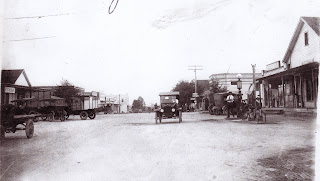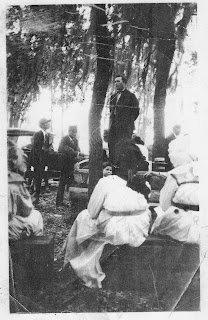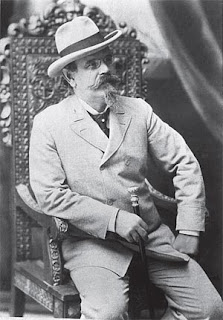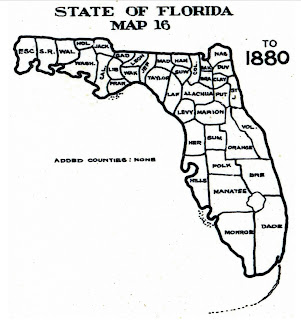1899 - Elliott Erastus Edge and Wife Cornelia Arrive in Taylorville
In the early part of 1899, Elliott Erastus Edge and his wife Cornelia, coming from Georgia, arrived in what was still known as Taylorville. They brought with them their four children: Kate, Bertha, Lacy Day (L. D.), and Freddie.
You can read more about their son L. D. Edge at the following pages:
1922 - L. D. Edge - Groveland's First Mayor
1923 - L. D. Edge Becomes the Youngest Speaker of the House of Florida
1950s - L. D. Edge, the "Father of the Department of Transportation"

The Edge family was described in the writings of Robert James Merritt's family (of Slone's Ridge) history:
"I have found the Edges to be nice honest truthful people every one of them.
They always helped the poor and needy far and near and was nice to everybody."
"Mr. E. E. Edge, with a group of Negro families (Andersons, Baldwins, Blues, and Wrights) came into the area from Georgia.
Some said they came in wagons drawn by oxen.
Some of the earliest white families to arrive were the Averitts, the Rices, and the O'Neals."
Mr. Edge brought with him several of his employees in the naval stores business, including the families of: Bill Faircloth, J. W. O'Neal, George W. Todd, Jack Driggers, and the Howards.
Early African American Families
Along with Edge came numerous African American workers and their families who rode to the area in wagons..
Albert S. Blue relocated to Taylorville along with the families of:
Mrs. Irene Adams,
John Baldwin,
Israel Gadsen,
Jim Hall,
Ike Hart,
Ben Maxwell.
Other family names found that may have come a few years later were:
Anderson,
James Brown,
Will Crawford,
Moses Harris,
Elliott Hodges,
Elijah Jones,
Henry Taylor,
and Wright.
All were recruited to come here by E. E. Edge.
Due to Albert Blue's efforts, the first African-American school was built in Groveland.

Many of these families have local streets named for them (Baldwin, Blue, Gadsen, Hart, and Wright).
Mrs. Cornelia Edge
Elliot's wife Cornelia was also highly admired by the local Black community. Teresa Baker Floyd shared heartwarming stories of how the Edge family helped people. One of her stories was of how Cornelia continuously supported two young Black teenage boys after the death of their parents. She supplied them with food and clothing. Later, when one of the boys moved away and was killed, Mrs. Edge made arrangements for his return and burial in Groveland, along with paying the funeral expenses.
Teresa Floyd left groveland in 1960 and moved to Washington D. C.. In time she would get a job working for Speaker of the House, Tip O'Neill, and would continue working at the U.S. Capitol for the next twenty-nine and a half years. At the time of this writing, she was 94 years old and living in Maryland.
E. E. Edge - A True Entrepreneur
Experienced in the naval store business (those products made from the sap of pine trees) for about ten years, upon arrival to this area, he bought the home and turpentine business of the Taylor brothers.
He would continue buying up stills and woodlands until he owned the land or turpentining rights for most of the pine forests from Clermont to Dade City. Old documents have been found that show him owning land as far away as Hillsborough County,
E.E. Edge would soon become one of Groveland's influencial founders.
A true entrepreneur, Edges's various businesses would soon include: turpentine operation, sawmill, farms, commissary, citrus groves, funeral service, the county's largest department store, hardware store, clothing store, furniture store, animal feed store, auto service and fuel station, and propane delivery.
In 1902, The Edge House was built by Elliott & Cornelia on the site of what is today Hardee's.
The Queen Anna style home is on the National Register of Historic Places.

In 1988, the house was moved 1 mile west on HWY 50, where it remains today.
When Edge first came to town, he used the Taylor brothers' commissary as a "trading post" for the early settlers to come and purchase or trade for goods. This was the beginnings of the Edge Mercantile Company and it was located on the north side of today's Groveland Post Office.
In 1905, Edge built a general store for the Edge Mercantile Company and post office, at the corners of what is now Broad Street and Main Avenue
By 1910, Edge built his furniture store across the street. It was located in the empty lot on the west side of the 1923 Edge Mercantile Building.
Edge's Telephone Company
The writings of the Merritt history also state:
"It was said that Mr. E. E. Edge bought the rights to the turpentine business... buying a huge block of long-leaf yellow pine in an area that stretched from Taylorille to Dade City.
He then had a line of turpentine stills that stretched from here to Dade City.
To communicate with these stills, he sent out a rider telling each still what they were to do."
Edge owned a number of turpentine camps (nine between here and Dade City).
For communication within his empire, he first used riders on horseback to run instructions to the various camps.
As technology advanced, Edge hired Otto Wettstein, Jr. to create a telephone network between the camps to send messages to the stills faster.
By 1925 Edge and Wettstein had formed seven separate telephone companies. That network grew into the Lake Telephone Company and eventually became the Florida Telephone Company. It started in the building that today houses Cheffing It Up Pizza. The Florida Telephone Company would continue on to become what is known today as Embarq.
About 1900 - A Young Lacy Day Edge Sitting in Buggy with Men Who Worked for E. E. Edge

Edge Island
Daniel Sloan is believed to have built the first house in the area that would become Taylorville/Groveland. After his death in 1888, his heirs inherited his property, which they later sold to E. E. Edge. The property became known as Edge Island. It is located about one mile northeast of downtown Groveland
1904 - The Edge Sisters
Around 1904, E. E. Edge's three sisters joined him in Taylorville. Laticia Edge was married to R. L. Averitt. Jane Edge was married to E. L. Rice. Bertha Edge would go on to marry a Maguire, but would later move to North Florida.
Other people knwon to have arrived prior to 1910 were: Addison Smith, Albert Cashwell, and Russell Brown (No relation to Browns of Brown's Ford).
1906-1907 - The Drought and Edge's Sawmill
During the years 1906-1907, a severe drought killed thousands of acres of pines, which made them useless for sap, but still good for lumber. It is thought that the heavy harvesting of the sap may have weakened the trees too much to survive.
Did E. E. Edge buy out the Taylors' small sawmill and expand it or did he begin his own?
It is not clear because another source states:
"The lumber mill originally was started by E. E. Edge after the turpentine business was severely crippled due to the drought of 1907 that killed many of the long-leaf pines."
In any case, E. E. Edge, began or continued his sawmill business, which was known as the Edge Lumber Company in 1907.
By 1908, Edge would form a partnership with Robert L. Dowling, a lumber baron, from Live Oak, Florida. The name was then changed to the Edge-Dowling Lumber Company. (Groveland local Dennis Bronson found a book showing a timber contract executed to the Edge-Dowling Lumber Company on September 14, 1908.)
Early Sawmill in Taylorville Located Along the North Side of Today's Crittenden Ave

1910 - J. Ray Arnold Rides To Town
J. Ray Arnold, a sawmill machinery salesman, rode into town in 1910, on horseback. He eventually stayed and would end up marrying Robert Dowling's daughter.
J. Ray Arnold

By 1917, Edge had sold out his interest in the sawmill to Robert Dowling. His son-in-law J. Ray Arnold soon took over Dowling's interest in the sawmill.
"There was a gentlemen's agreement between J. Ray Arnold and E. E. Edge.
J. Ray Arnold ran the sawmill, while Edge ran the turpentine business and the mercantile business.
They would work together in managing the town.
This agreement, whether true or not, was honored until the end of the sawmill at which time Edge then ran the town." - Julian Rowe (b. 1915 in Taylorville)
Abt. 1912 - Looking Westward along Today's Crittenden Blvd

1915 - Downtown Taylorville - Looking East from the Intersection of HWY 50 and HWY 19

1915 - Downtown Taylorville - Showing the First Bank Building on the Corner of HWY 50 and S Main Ave.

1915 - Lacy Day Edge Becomes The Youngest Ever Speaker of the Florida House of Representatives
Lacy Day Edge, son of E. E. Edge, also made noticeable accomplishments.
Beginning in 1915, he represented Lake County as a state legislator and, in 1923, became the youngest ever Speaker of the Florida House of Representatives at age 25.
He would also serve in the Florida Senate.
1914 - Lacy Day Edge - Speaking During His 1st Race for Member of House of Representatives

L. D. Edge (center) During the Signing of a Bill While Serving as State Representative

Around 1898, E.E. Edge purchased the Crenshaw holdings south of Lake Louisa, and before the end of 1917 county commissioners appointed Hon. L. D. Edge, of Groveland, H. L. Johnson, and S. S. Fesler to a commission that would have charge over the preliminary work of draining the marsh.
This is what Steve Rajtar wrote for the Groveland Mascotte Historical Trail [Note: There are some errors in the following quote *]:
"The severe freezes in 1894-95 hurt the citrus industry, and this area of Lake County turned to turpentine.
T. M. and C. C. Taylor sold their turpentine still in the southern portion of the county and went to Mascotte, planning to start tapping pine trees with a crew of black laborers.
However, since Mascotte had never had a black resident, town leader Theodore Ruff refused to let the Taylors set up shop.
The Taylors then followed the railroad eastward to a place they named Taylorville, and erected a still on the lot where later L. Day Edge [*E. E. Edge] built his home.
His father, Elliott E. Edge, bought out the Taylors in 1899 and laid out the foundation of a town."
Referred to as the "Father of the Department of Transportation", L. D. Edge influenced the building of Highway 50 through Groveland.
L. D. Edge became the first mayor of Groveland when the town was incorporated in 1922.
By the 1920s and '30s, many of the businesses in the downtown area were owned by the Edge family.
The Edge Mercantile Company was built in 1923 and was, at the time, one of the largest in the state.

Upon entering the 1923 Mercantile, one would find clothing on the first floor.
There was a machine in the large shoe department that one could stick their feet into to determine their shoe size.
Clyde Plowden, the clerk, would help children try on a new pair of Buster Brown shoes.
The second floor could be reached either by the stairs or what felt like "the world's slowest-moving elevator".
On the second floor were bolts of material, various sewing needs, linens, and rugs, among other merchandise.
With each purchse customers were given "green stamps".
At Christmas time, Santa Claus always made a visit.
Residing on the second floor, he would listen to children's Christmas wishes.1
Also, in the center of the first floor, was the Lake Drug Company.
Since the proprieter of a drug store was required to have a special license, it was one of the few stores in Groveland that was not owned by Mr. Edge.
He rented out space in his mercantile building to the pharmacist, Dr. T. Grady McFadden.
Lake Drug Co. had its own soda fountain and was a favorite place for socializing for several decades.
During the 1950s, a cherry coke in a glass cost 5 cents or 7 cents in a paper cup.
More Memories of the Edges
They bought and sold whatever the public wanted, from trinkets to farm implements.
People throughout the Central Florida area were known to come to Groveland for their shopping needs.
It was said that you could come to Groveland and buy everything you needed in one day, except for a car.
Julian Rowe, born in Taylorville in 1915, once shared how he, as a young boy, was hired to ride on the running board of a car and pass out sale flyers to homes.
His route went south to the Polk County line, west almost to Dade City, back through Sumter County, and east to the Winter Garden area.
Edge Enterprises also included:
a hardware store,
furniture and appliance store,
feed and seed store,
drug store (complete with soda fountain),
funeral home,
grocery (which later evolved into Groveland's A & P),
dry goods and clothing,
vast acres of pine forests and citrus groves,
heating oil and propane gas company, and
Edge's fuel station (located at Broad Street and Highway 19), which held the record for being the longest privately-owned fuel station in the country.
1920s - Edge Makes a Mint
With the banking problems of the 1920s and 1930s, it was common for businesses to print or mint their own money. So following the bank failures in Groveland during the 1920s, Edge began minting his own currency that was called "lumies", because they were coins made of aluminum. The coins were accepted throughout his stores.
One town legend says that a man moved in and began counterfeiting Edge's lumies. He was eventually discovered and the counterfeit coins were dumped into Lake David.
Edge soon stopped making the company currency.
1934 - In Memory
At E.E. Edge's death in 1934, being one of nine charter members of the First Methodist Church in Groveland, the church voted unanimously to change the name to the Edge Memorial Methodist Church in honor of his support of the church and Methodist-supported missions, including Florida Southern College.
Constructed in 1922, the second oldest building on the campus of Florida Southern College in Lakeland, Florida, was renamed Edge Hall in 1935 to honor E. E. Edge, who was one of the first large donors to the college.
Edge, and his son Lacy Day Edge, were lifelong members of the church
Following the death of his father in 1934, Lacy Day (commonly known as Day Edge) gave up his rise in politics to return home to assume the responsibilities of running the various Edge businesses.
L. D. Edge standing with the artist during portrait unveiling in Tallahassee, Florida

[Contributors: Julian Rowe, Mary Helen Myers, Jason Brown]




























